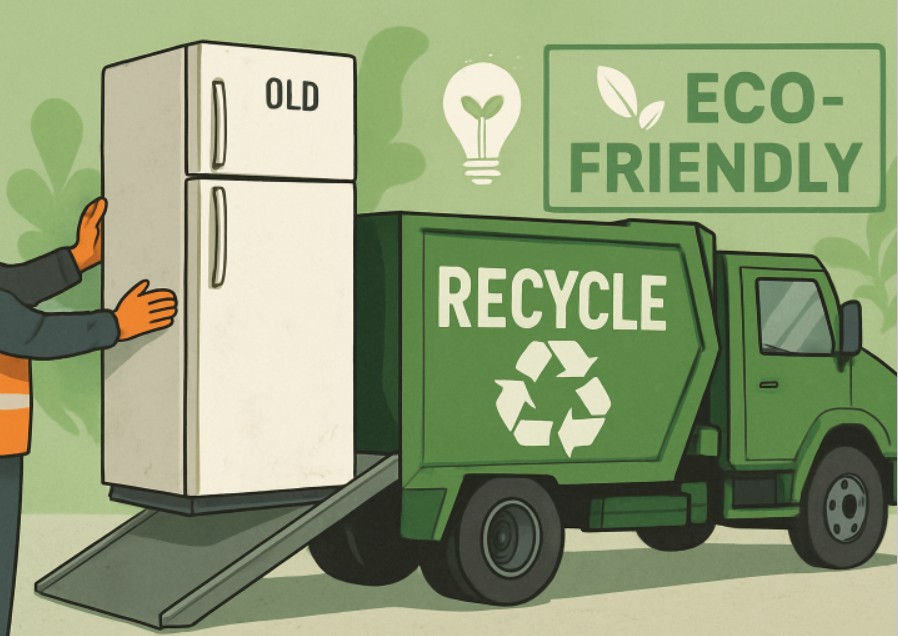Why Proper Refrigerator Disposal Matters
Each year, thousands of households upgrade their appliances, but what happens to the old refrigerators? Proper refrigerator disposal isn’t just about clearing your space—it’s an essential step for protecting the environment and community health. Older refrigerators, especially those manufactured before 1995, often contain refrigerants like Freon and other chemicals classified as ozone-depleting substances. According to the United States Environmental Protection Agency, improper disposal of these refrigerants can cause serious environmental harm, contributing to both ozone depletion and climate change.
Ensuring responsible removal means working with a reliable refrigerator disposal service that can safely handle the chemicals and materials inside old units. These experts follow strict guidelines for extracting, recycling, or disposing of refrigerant gases, foam insulation materials, and recyclable metals, minimizing harm while maximizing materials recovery. They undergo specialized training to stay updated on the latest environmental regulations and safety protocols. Additionally, their work helps reduce pollution and conserve natural resources, supporting sustainable practices across industries.
Common Dangers of Improper Disposal
Improper fridge disposal poses real risks. When old units are dumped in landfills or abandoned outdoors, hazardous fluids like Freon or oil can seep into the ground, polluting soil and groundwater. This contamination poses a threat to local ecosystems and drinking water. Additionally, old refrigerators left unattended can create safety hazards—children and animals could become trapped by accidentally closing the heavy doors. On top of that, the insulation foam inside older fridges often contains substances that break down into potent greenhouse gases, further increasing global warming.
Responsible disposal safeguards both people and the planet by ensuring refrigerants, oils, and other hazardous materials are properly handled and by reducing greenhouse gas emissions.
Sustainable Options for Old Appliances
A wide range of sustainable solutions exists for discarding refrigerators. Many municipalities provide specific drop-off centers, and some offer curbside pickup for larger appliances. Appliance retailers often partner with recycling programs, especially when you’re purchasing a new replacement. Specialized recycling centers extract and responsibly manage hazardous components while salvaging metals, plastics, and glass for reuse. Today’s innovative “appliance recycling” programs help reclaim resources and drastically reduce landfill waste.
Before arranging a pickup, check with your local sanitation department for guidance or look for regional take-back events. Major home improvement chains and electronics stores also hold recycling drives that accept large household appliances. Reputable recyclers are certified by organizations such as the Responsible Appliance Disposal (RAD) program, ensuring each step meets environmental and safety standards. The New York Times Wirecutter guide on appliance removal provides additional tips for finding legitimate recycling options in your area.

Preparing Your Refrigerator for Removal
How to Ready Your Unit for Safe Collection
- Remove all food and beverages from the interior. Dispose of perishables properly.
- Unplug the refrigerator and allow at least 24 hours for it to defrost. This ensures there’s no ice or excess water that could leak during removal.
- Secure any loose shelving or drawers to prevent breakage while moving.
- Wipe the interior and exterior clean to avoid odors and make handling easier for recycling staff.
- Double-check the drainage trays or ice maker for leftover water.
These steps not only protect movers and the environment but also ensure you comply with most recycling facility requirements.
Eco-Friendly Recycling Processes
Appliances collected by certified facilities undergo careful dismantling designed to protect environmental and public health. Trained technicians safely extract refrigerants and oils with specialized equipment, preventing accidental release into the atmosphere. The refrigerator is then processed, with metals, plastics, and glass separated and sent for recycling. According to the EPA’s RAD program, such recycling initiatives reclaim significant resources and prevent pollution, helping reduce reliance on new raw materials and conserve energy throughout the supply chain.
This rigorous recycling process is essential for minimizing a refrigerator’s ecological footprint and ensuring materials are put back into productive use rather than becoming environmental hazards.
Donation and Reuse Opportunities
If your refrigerator is still in working order, consider donating it to organizations that support families in need, schools, or shelters. Many local charities or Habitat for Humanity locations accept gently used appliances for redistribution to those who can’t afford new ones. By extending the life of your equipment, you benefit your community and decrease unnecessary production and waste. Donation programs often pick up large appliances directly from your home, adding convenience to sustainable generosity.
Check with local nonprofits or search for community programs that offer free pickup for reusable appliances.
Local Guidelines and Community Resources
Disposal regulations for refrigerators vary widely by city, county, and state. Some areas ban the dumping of appliances containing CFCs (chlorofluorocarbons), while others require special handling and documentation. Contact your local waste authority for the most up-to-date rules. Many municipalities offer periodic large-item disposal programs or rebates as incentives for responsible recycling and may list approved drop-off locations on their official websites.
Staying informed about local regulations not only avoids fines but also ensures your fridge is dismantled and recycled in a safe, legal, and eco-friendly way.
Step-By-Step Checklist For Disposal
- Empty and clean the refrigerator.
- Unplug and defrost 24 hours before removal.
- Research local disposal or recycling rules and find an authorized collection service.
- Prepare paperwork or labels required by your sanitation provider or recycling center.
- Decide whether to recycle, donate, or arrange curbside pickup based on condition and local options.
- Remove doors or tape them securely shut for safety during handling.
- Document your disposal for rebates or personal records, if needed.
Conclusion
Disposing of an old refrigerator responsibly is a straightforward way to help protect the environment and your community. Working with a reliable, certified service ensures hazardous materials are properly managed, while recycling and donation options give appliances a second life. Always check your local guidelines and look for certified programs to make the most eco-friendly choice possible. Each action—whether recycling, preparing safely, or choosing to donate—contributes to a healthier planet and a more sustainable future, one appliance at a time.
